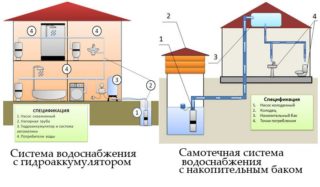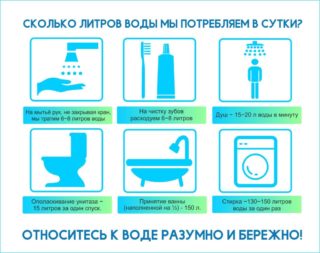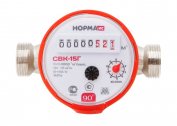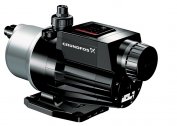If it is not possible to connect to the central system, an independent autonomous water supply network is established. Such water pipes are mounted in private houses, since multi-apartment ones are almost always connected to the city-wide supply line. It is necessary to arrange individual water supply in such a way that there is unhindered flow to all points of water intake.
The main components of autonomous water supply
 For normal operation, the system is equipped with devices and technical devices that provide automatic or partially automated operation:
For normal operation, the system is equipped with devices and technical devices that provide automatic or partially automated operation:
- submersible pump;
- automation and protection unit;
- accumulator;
- filtering devices.
When choosing pumping equipment, consider the pressure and volume of water consumption. This will provide the necessary fluid pressure in the pipeline.
Principle of operation
 The hydraulic accumulator is used as a buffer tank, accumulating a supply of water, and as a device to maintain constant pressure. The hydraulic tank consists of two compartments - for air and water, they are separated from each other by a diaphragm made of rubber. The principle of operation of the equipment is as follows:
The hydraulic accumulator is used as a buffer tank, accumulating a supply of water, and as a device to maintain constant pressure. The hydraulic tank consists of two compartments - for air and water, they are separated from each other by a diaphragm made of rubber. The principle of operation of the equipment is as follows:
- When filling the accumulator with water, air is compressed in the second compartment, which increases the pressure.
- In response to its increase, the electronic relay turns off the pump.
- When the tap is opened, the pressure gradually decreases.
- The relay again responds to a decrease in pressure and starts the pump unit to replenish the spent water.
The use of a hydraulic accumulator in the arrangement of the water supply network allows you to create an automatic process of water intake and ensure its supply. The operating time of pumping equipment is also significantly increased due to the reduction of on and off cycles.
Advantages and disadvantages
An autonomous system has many advantages. Among them:
- optimal pressure at all points of water consumption;
- stock in the storage tank;
- high quality water.
Among the shortcomings can be noted the costs of equipping your source of drinking water and the dependence of the pumping unit on power supply.
Materials and equipment
In addition to the main elements for conducting the mains to the house, pipe sections for water supply inside and outside, locking elements, fittings, taps, mixers and flexible leads to them, pipe fittings, check valves, and water meters will be required. Fum tape or sanitary flax are needed to seal threaded joints. If you need hot water, you can install a water heater or use a boiler.
Of the tools for assembling the system you will need:
- special scissors;
- two adjustable spanners and one gas;
- calibrator (for metal);
- soldering station for polymer pipes;
- level, roulette.
For water supply, polymer or metal-plastic pipes are chosen, since similar metal products rust over time, due to which the water will become an unpleasant color and taste.
Preliminary calculations
 To correctly determine the parameters of the water supply network, you will need:
To correctly determine the parameters of the water supply network, you will need:
- Formulate requirements for the intensity and regularity of water supply. In a small cottage, you can install a system with a conventional storage tank and the most necessary set of plumbing.
- Identify potential sources, feasibility and cost of their construction, water quality.
- Select equipment and calculate options for communication lines.
Calculations should be started by determining the required volume of water. A family of four for cooking and water procedures with economical consumption is enough for a cubic meter of water for each month. Based on these data, the power of the pump unit is calculated.
Choosing the Right Scheme
For autonomous water supply at home, a permanent water source is required. The easiest way to equip a well. This is the most affordable and inexpensive option to provide home water. However, the drawback is great - the maximum amount of water pumped from the well is 200 liters per hour. A well is more productive, but it requires drilling costs.
Private water supply can be single-level and two-level. The principle of operation of the first is that water from a well or a well is used immediately after pumping. The second difference is the use of reservoirs that create a supply of water. They are cylindrical or prismatic in volume from 560 to 4,500 liters, made from polyethylene or polyvinyl chloride.
The service life of the containers is approximately 10 years. The best way to install a vessel having a volume of one to five cubic meters will be the above-ground option in the free space of the site.
Installation Steps
 The external section of the water main must be laid at a depth exceeding the level of soil freezing. If the pipes are above this point, the use of heat-insulating materials or the installation of special heating to prevent freezing of the liquid in the pipeline will be required.
The external section of the water main must be laid at a depth exceeding the level of soil freezing. If the pipes are above this point, the use of heat-insulating materials or the installation of special heating to prevent freezing of the liquid in the pipeline will be required.
Installation of external and internal water supply does not have fundamental differences.
Propylene pipes are connected by soldering. To do this, on the one hand there is a heating drone on the soldering iron, the required fitting is put on it, and on the other, a heating sleeve into which the pipe is inserted. After heating, they are removed from the soldering iron and, having connected with each other, are allowed to cool in a stationary position. It is important not to overheat the product, as this can lead to blockages in the future.
Metal-plastic products are connected using crimp shaped elements under the nut. At the place of entry into the house, a metal or plastic sleeve is put on the pipe.
Step-by-step instruction:
- A filter and a check valve are installed in front of the pump. After - pressure gauge and pressure switch.
- The pressure unit is connected to the control panel and to the internal water supply system. If a submersible pump is used, it is controlled by a float sensor located in the storage tank.
- If the station is installed on a surface close to the well, a special container is used - a caisson. For its arrangement, they dig a pipe to a depth of 2.5 m. In this case, the diameter of the pit should be twice the size of the caisson. At the bottom lay a 20 cm concrete pillow. The pipe should protrude above its surface by 0.5 m. The excess part is cut off.
- They dig a ditch for laying a water supply line, 1.8–2 m deep. A pump is installed in the caisson, connected to the suction and drain pipes. Next, the container is poured around the perimeter with concrete with a layer of about 0.4 m.
- When the concrete sets, the remaining space is filled up with cement-sand mortar, leaving about 0.5 m of free space. It is then filled with soil.
- According to the scheme in the house, an independent installation of a hydraulic tank with a pressure switch and other necessary devices is performed. Devices are connected to the electrical network and among themselves.
When all devices are connected, the necessary settings are set, you can start testing. During the control test, you need to examine the nodes of the connections for leaks.
You can install a water supply system in the house with your own hands. But it is better to entrust commissioning to specialists, especially if the pressure system is complex in design.


